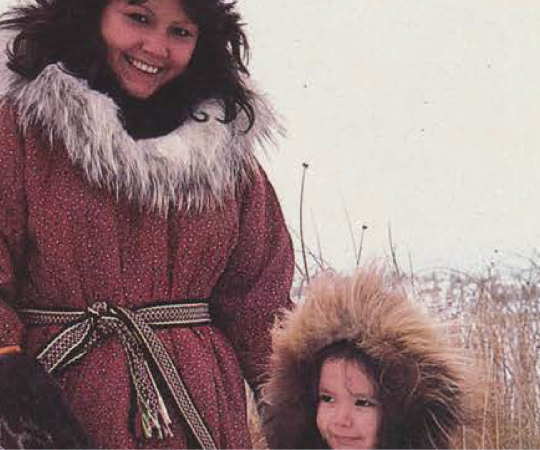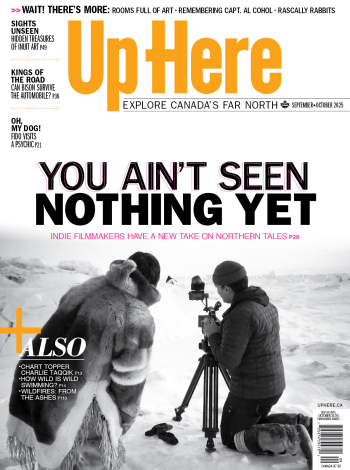Hoarfrost sparkled on the trees and thick layers of snow crunched under Brenda Dragon’s mukluk-clad feet. The cold wind whipped past her face and ruffled the fur lining her hood, as she walked the quiet streets of Fort Smith. Dragon stretched out her fingers, cozy inside the soft beaver fur mitts her mother had made for her, and carried on to school as if she were in her own personal bubble of warmth.
On these winter mornings as a kid, Dragon remembers feeling superior to the frigid temperatures.
“As humans, we were not born with fur on our backs. We were always meant to wear fur,” she says. “I grew up wearing fur, and was never cold.”
Fur has played a central role in Dragon family life for generations. “Our family tree is full of trappers—my grandparents, my parents, and, as it turns out, my daughter and her partner are trapping in the Fort Smith area,” she says “It’s a deep part of who we are as Northern people.”
Dragon has been carrying on the tradition with Aurora Heat—a company the Dënësųłinë́ and French Canadian entrepreneur founded in 2015 that sells fur hand and feet warmers, among other items. (Aurora Heat is a family affair too—Dragon’s son Joel works with her as a marketing specialist.)

The small, handmade patches consist of the wool from sheared beaver fur. Each patch can be placed inside mitts, boots or a hat to provide an extra layer of protection against the cold. The patches can be used for years—for a lifetime, even—as opposed to the disposable warmers people buy from plastic packages that only last a few hours.
Real fur is also a big step up from faux fur, says Dragon. The imitation stuff, she explains, is actually made with thousands of pieces of micro-plastics and faux fur doesn’t keep its form for long, even though the plastic remains in landfills for centuries. “We have all seen the fake fur on a coat looking terribly ragged in no time at all,” says Dragon. Yet authentic fur comes from animals who evolved over countless winters to grow coats that perfectly insulate them from frigid temperatures
But when it comes to selecting a specific fur to keep you warm, it really depends on what you’ll use your garment for.
Iqaluit’s Emily Joanasie sells numerous types of furs—from fox, coyote and racoon, to seal skin—at her fabric shop, Miqsuqta!. While every animal’s fur provides a degree of warmth, each serves a different purpose, she says.
For instance, fox fur tends to sell the fastest, but many hunters—including Joanasie’s father—opt for other animals. “Fox fur is a little too delicate for [my father],” she says “It holds more moisture.” Although fox fur will still keep you warm, its fluffy hairs are more fashion than function. Shorter fur, from coyotes for example, is not as long, but denser and absorbs less moisture, making it ideal for longer hunting trips out on the land. It sounds contradictory, but some shorter furs are warmer than longer furs because the longer ones are meant to protect from wind rather than maintain heat.
Dragon notes that many animals have two layers of fur, and these furs prove the best at keeping the cold at bay. A beaver’s longer guard hairs are stiff and protect the animal from things like branches, while also allowing it to easily glide through the water, she explains. The shorter layer, or the wool, is closer to the skin and that’s what works to hold in heat. “Beaver is very durable and ever-lasting,” she says. “Wild fur is an incredible insulator.”
Sealskin, on the other hand, is not as effective in retaining heat, but it’s great for its waterproof qualities—that is, of course, if you buy it from someone who knows how to treat it. “Sealskin, if traditionally processed, will be waterproof because of the natural oils it contains,” Joanasie explains. “But if it is commercially tanned, it loses its waterproof properties because the oils
are extracted.”
That’s a good tip in general for purchasing fur and sealskin products—it’s best to buy locally from hunters, trappers and Northern designers who do everything by hand. Because, really, people who experience harsh weather understand how to dress for it.
For designers like Joanasie and Dragon, real fur products are more than just an accessory—they’re part of their culture, heritage and everyday life.
“It’s critical to support all arts, period,” says Dragon. “Supporting local Indigenous designers builds pride in Northern culture and allows us to practice and share our traditional ways while participating in the economy. It’s an act of reconciliation.”
Plus, you can’t enjoy the wonders of winter when your fingers and toes are frozen.










